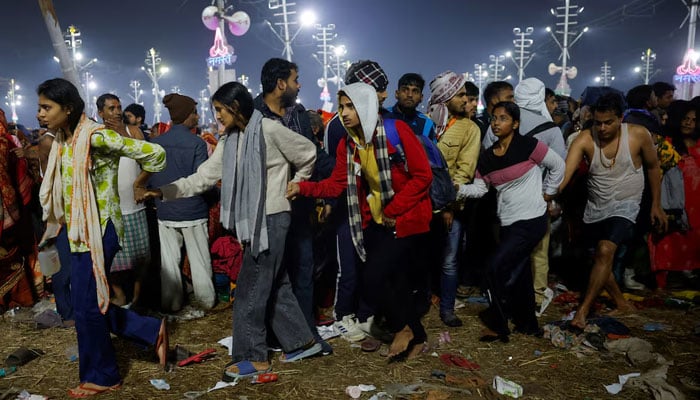NEWS
15 killed in India stampede at Hindu mega-festival

Organisers likened the scale of this year’s festival to that of a temporary country
festival to that of a temporary country
By AFPJanuary 29, 2025
Devotees hold hands as they leave after a stampede before the second Shahi Snan (royal bath) at the Maha Kumbh Mela or the Great Pitcher Festival, in Prayagraj, India, January 29, 2025. — Reuters
Devotees hold hands as they leave after a stampede before the second “Shahi Snan” (royal bath) at the “Maha Kumbh Mela” or the Great Pitcher Festival, in Prayagraj, India, January 29, 2025. — Reuters
A deadly stampede at the Hindu Kumbh Mela festival, the world’s largest religious gathering in India, left at least 15 people dead and many others injured on Wednesday, according to a doctor at the scene.
Deadly crowd crushes are tragically common at Indian religious events, and the Kumbh Mela has a notorious history of such incidents, AFP reported.
The festival, spanning six weeks, marks a crucial date on the Hindu religious calendar, attracting millions of devotees for ritual bathing.
The latest tragedy occurred in the early hours of Wednesday as participants gathered for the the religious event.
“At least 15 people have died for now. Others are being treated,” said the doctor at the festival site in Prayagraj, speaking on condition of anonymity as they were not authorised to talk to media.
Rescue teams were seen working with pilgrims to carry victims away from the site of the accident over ground strewn with clothes, shoes and other discarded belongings.
Police officers moved through the area carrying stretchers bearing the bodies of victims draped with thick blankets.
Dozens of relatives were anxiously waiting for news outside a large tent serving as a purpose-built hospital for the festival around one kilometre from the accident.
Wednesday marks one of the holiest days in the festival, when saffron-clad holy men were due to lead millions into a procession of sin-cleansing ritual bathing at the confluence of the Ganges and Yamuna rivers.
But instead officials were strolling the festival site with loudhailers urging pilgrims to keep away from the waterways.
“We humbily request all devotees do not come to the main bathing spot,” said one festival staffer, his voice crackling through his megaphone.
“Please cooperate with security personnel.”
Numerous pilgrims decided to make an early exit from the festival.
“I heard the news and saw the bathing site,” attendee Sanjay Nishad told AFP. “My family got scared, so we’re leaving.”
Local government official Akanksha Rana told the Press Trust of India (PTI) news agency that the stampede began after the collapse of some crowd control barriers.
Pilgrim Malti Pandey told AFP that he was on his way to bathe in the river along a barricaded walking route when the stampede began.
“Suddenly a crowed started pushing and many people were crushed,” the 42-year-old said.
The Kumbh Mela is rooted in Hindu mythology, a battle between deities and demons for control of a pitcher containing the nectar of immortality.
Organisers have likened the scale of this year’s festival to that of a temporary country, forecasting up to 400 million pilgrims to visit before the final day on February 26.
Mindful of the risk of deadly crowd accidents, police this year installed hundreds of cameras at the festival site and on roads leading to the sprawling encampment, mounted on poles and a fleet of overhead drones.
The surveillance network is fed into a sophisticated command and control centre that is meant to alert staff if sections of the crowd get so concentrated that they pose a safety threat.
More than 400 people died after being trampled or drowned at the Kumbh Mela on a single day of the festival in 1954, one of the largest tolls in a crowd-related disaster globally.
Another 36 people were crushed to death in 2013, the last time the festival was staged in the northern city of Prayagraj.
Source: thenews.com.pk







